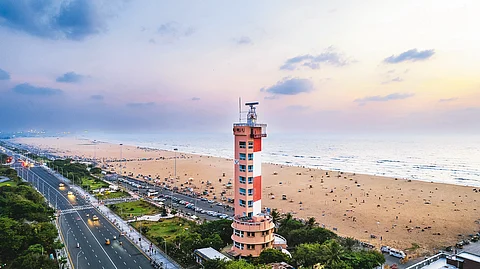
- Destinations
- Experiences
- Stay
- What's new
- Celebrating People
- Responsible Tourism
- CampaignsCampaigns
- Subscribe
- Buy Now

Chennai, once known as Madras or Madras Patnam, is a city shaped by centuries of maritime trade, colonial architecture, and layered cultural identities. What began as a humble fishing village on the Coromandel Coast transformed into one of India's most important urban and port centres. The East India Company's decision to acquire the village of Madraspatnam on August 22, 1639, set in motion a story of commerce, colonisation, creativity, and community. Today, the city continues to balance tradition and modernity, spirituality and software, Carnatic music and cutting-edge cinema.
In 2004, city chronicler S. Muthiah, along with journalists Vincent D'Souza and Sashi Nair, envisioned Madras Day as an annual celebration to honour the city's founding. What started as a handful of events quickly became a month-long festival that draws participation from across neighbourhoods, generations, and interests. From heritage walks and public lectures to film screenings, food trails, and photography contests, Madras Day is about engaging with the city—its past and present—in meaningful ways.
The date, August 22, marks the signing of the land grant by local Nayak rulers to the East India Company, making it the city's widely accepted birthday. While there are historical debates about whether the deed was signed in July or August, what remains undisputed is the growing love that Chennaiites have for their city and the collective efforts to preserve its history.
One of the most enduring legacies of Madras’ colonial past is its architectural heritage. At its core lies Fort St. George, built in 1644 by the British East India Company, around which the city gradually took shape. Today, the fort remains a living monument—it houses the
Tamil Nadu Legislative Assembly and within its ramparts stands St. Mary’s Church, the oldest Anglican church in India. Visitors can also explore the Fort Museum, which showcases colonial artefacts and portraits. The fort is open from 9 am to 5 pm on all days except Friday. Entry fees are modest: INR 5 for Indian nationals and INR 100 for foreign visitors. The museum charges INR 15 for Indian adults and INR 200 for foreigners, while children under 15 can enter free of cost.
Moving further inland from the coast, colonial-era Chennai unfolds in architectural splendour. The Indo-Saracenic Senate House of the University of Madras, designed by British architect Robert Chisholm, is a brilliant example of the hybrid design sensibility that defined much of the city’s colonial architecture—blending Indian motifs with European elements. Not far from here stands the iconic Ripon Building, a stately Neoclassical structure crowned with a 132-foot clock tower. Since 1913, it has served as the headquarters of the Greater Chennai Corporation. Today, visitors can also partake in heritage walks organised around this landmark and other historic sites—details of which are available on the GCC website.
Chennai’s colonial past shapes its present through enduring public buildings. The Royapuram Railway Station, India’s oldest, showcases Renaissance-style architecture. Nearby, the Madras High Court, an impressive Gothic structure, and Victoria Public Hall, a colonial-era cultural venue, remain iconic landmarks. The Egmore Museum, one of India’s oldest, houses remarkable archaeological, numismatic, and bronze collections (open 9:30 am–5 pm; closed Fridays and national holidays; entry INR 15 for Indians, INR 250 for foreigners; free for children under 15). The University of Madras, established during British rule, continues to thrive as a leading academic institution in Chennai.
While the buildings speak of the past, it's the people who keep the spirit of Madras alive. Madras Day celebrates this living heritage of communities who speak different languages, worship in temples, churches, and mosques, run Carnatic sabhas, street food stalls, film studios, and tech startups.
It's about school children discovering their city through quizzes, senior citizens reminiscing through storytelling sessions, and artists and historians mapping the evolving cityscape.
Madras Day is not just about looking back. It is about understanding where we come from, how we live today, and where we're headed. It is a reminder that cities, like people, are always evolving. In Chennai's case, the past is never too far from the present, and Madras Day is the perfect time to rediscover that connection.
Whether you're a lifelong resident or a curious visitor, the month of August offers a chance to experience Chennai as more than a city. As a living archive of memory, movement, and meaning
